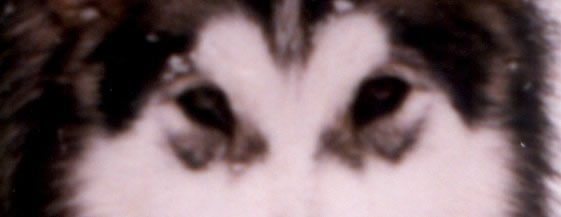
Malamutes have wolf in them don't they?
I've heard they are part wolf...
He looks like a wolf...
How many times have we heard that???
Northern breeds are often mistaken for wolves, or wolf-dog mixes by the public so anyone who has owned a Malamute is often asked "Is he a wolf?". It's probably those intelligent eyes! It is part of your responsibility as a responsible Malamute owner (or future owner) to explain "No" and "why not". Malamutes share many traits with wolves because they are dogs - and more so because they are a natural breed. A natural breed has not been shaped by man into a specific mold for a specific purpose.
The only purpose Malamutes were shaped for is pulling and confidence around man. They were allowed to be alert dogs - barking to warn for polar bears or wolves (perhaps that's where the dog aggression comes from?) and not much else. Whereas when other breeds were being developed they consciously chose to retain many puppy characteristics to make them more manageable and useful (especially for a farming economy). Fetching, playfulness, barking, giving up the kill to a superior, not killing the livestock and 'obedient' submissive behavior are examples of these characteristics.
The Malamute was allowed to retain many wolfy characteristics in look and behavior because it benefited a nomadic people to have a dog that could survive on it's own. Examples are a developed prey drive and 'pack' behavior most other dog breeds are lacking. Other breeds are not nearly as 'pack' oriented as a Malamute is.
Like the wolf, the Malamute shares a strong bond with his pack. In a litter of Malamute puppies you can have very distinct personalities - from very very dominant and very wolflike to very very submissive or golden retrieverish and from outgoing, confident, boisterous (doglike) to shy and skittish (wolflike) and everything in-between. (A good reason to let the breeder choose the pup for you so you don't get more than you can handle!). It's not because there is wolf a few generations back in the Malamute's genetic makeup - it is because there is still a diversity of genetic traits available to appear - nothing has been systematically eliminated.
When a Malamute grows up and becomes an adult, it doesn't retain much in the way of 'man made' puppy characteristics - they are not necessarily playful in a puppy sense (although they do have a sense of humor!), or obedient, or subservient. They have CHOSEN over thousands of years to be a companion and partner with man - so in the Malamute's eyes - he is our equal (it's your job to earn Alpha status and convince him otherwise).
When a Malamute grows up he becomes an ADULT - a REAL Adult. That is why you'll take a Malamute puppy to the dog park and it's fine with the other dogs UNTIL it grows up. Once it grows up, as a true adult, it demands respect and good manners from the other dogs (who may have no clue what that entails because they are still mentally puppies). When the other dogs don't use good manners (no staring, barking, playing when they should be dignified ADULTS) the Malamute becomes upset and often feels he must correct the upstart and a fight ensues. When they grow up, they acquire a certain sense of maturity other breeds never attain. Often the only remaining 'puppy' characteristic is his upturned plumey tail - the symbol of puppy overconfidence and plucky attitude!
They are a purebred
dog - pure as any other purebred dog. They have just not had many of the visible
wolfy characteristics bred out through selective breeding. They
may exhibit visible traits such as a dark patch of hair at the base of the
tail covering a scent gland, they may have black hair on the end of the tail,
black on the gums, an agouti coat (stripes of black and white on the guard
hairs), light yellow eyes and numerous other characteristics common to wolves.
Sometimes you'll hear that they were bred to wolves....well, that's essentially fiction. Any bitch staked out would be KILLED by a pack of wolves - because she wasn't a part of the pack. Possibly on RARE occasions it worked (maybe with a lone wolf or wolf without a pack when she was at the height of her season), but generally, NOT. The only time you get mixes like that are if irresponsible people do it - creating a very conflicted animal which is neither at home in the wild nor a home.
The lone wolf who would breed a dog is in danger himself - and to be caught in the uncompromising position of a tie would likely get him killed as well. This is "tough-guy" fiction. It's a fantasy and makes for good stories and reading, but is not true. Unfortunately, like the Pit Bull Terrier, the Akita, the Rottweiler and a few other breeds, Malamutes attract a certain percentage of lowlife 'tough guy' types who get their manliness from owning a 'tough dog' and if they can brag it has wolf and justify it with a few stories, it sounds even better! (too bad they have to get their self-esteem from a DOG!)
The unfortunate truth is, however, Malamutes are used quite often to breed to wolves or wolf-dog mixes because of their rugged and natural good looks. They are often used as 'wolves' in Disney films and on TV because they are trainable. If there is Malamute involved in a mixed breed litter, it's easy for an unethical breeder to sell the pups for more money if they're called wolfdogs rather than mutts. The unsuspecting public is tricked into buying wolfdogs that may or may not contain any true wolf.

Nova, aka Bog of Dog (100% Malamute)
Unfortunately, this does a major disservice to our breed, the Alaskan Malamute. Due to this intentional obtrusion of the facts, Malamutes are blamed for more bites, destruction and bad behavior than they should be. I'm not saying the Malamute is a perfect dog (they can be quite a handful in the wrong hands!) but they are blamed for much more than their share. Having done rescue, I've seen this first hand. A dog that was bragged about as a wolfdog (and likely was) would suddenly become a Malamute after it bit someone and they wanted to get rid of it!
I could go on and on, but Wolf Park has put together an EXCELLENT series about the differences between dog and wolf, the characteristics of hybrids and more. It is an excellent piece of work with great photos and anyone curious about the differences between wolves and dogs or wolf-dogs should read it. If you wonder where I stand on this issue - I look at it this way:
A Malamute is a fantastic dog - but can be a handful and very challenging to own for most people - and enough to make even a dedicated dog lover tear his hair out in frustration at times! Personally, I would not want a pet MORE difficult or that may be potentially more dangerous in the wrong hands. It's easy enough to screw up a Malamute! Consider the potential of doing the wrong thing if that dog has recent wolf ancestry with characteristics such as a STRONGER prey drive, STRONGER pack drive and a SHY/DEFENSIVE fear of humans in the depths of his genetic pool.
Scientifically Deterimined Differences in Appearance: Malamutes and Wolves
Wolf |
Malamute |
| Narrow chest | More rounded chest on mature animal |
| Legs proportionally long | Thicker legs (young or poorly bred dogs can look leggy) |
| Larger head, yelloww or gold eyes | Broader head, eyes usually darker and brownish |
| Gums and footpads are black | Gums and footpads can have pink spots |
| No clear definition of a "mask" | A clearly defined mask - whether all white or with dark markings around the eyes and down the nose. |
| Larger, often splayed feet | A tighter more compact foot |
| Tail is carried low | Tail carried over the back or lying on the back |
| Hyperactive and impossible to potty train |
Trainable and laid back and relaxed in the home when nothing is going on |
| Suspicious of humans | Friendly to humans |
Genetics:
In solving the human genome it was discovered we are no more than 1% different from one another - in other words, 99% of our genes are the same across all races from prehistoric to present. At present, no difference genetically can be found between dogs and wolves. So genetically, a poodle or shih tzu is the same genetically as northern timber wolves. The basic difference that has not been found by geneticists, is that for centuries man has controlled the gene pool of dogs. Through selection he has been able to eliminate characteristics he didn't want.
Genetically, they are probably still there - and if left to nature might even return. But because man still controls breeding of dogs - (even wild ones on the streets are not able to interact with genetically similar wolves) those traits we attribute to wolves have become dormant and not often seen.
Man has selected puppies that had characteristics that would benefit man to continue breeding. If he was seeking to breed a hunting dog, he might select the puppy that was most likely to carry a bird home for him without eating it. If he wanted a carting dog, he would choose the pups that had a willingness to wear a harness and pull a cart. If he wanted a dog to alert him to intruders, he would choose the "barky" one. In general man chose dogs that retained puppy characteristics he liked - barking (vs. howling), a wagging tail, willingness to obey and accept man as a leader. Long domesticated dogs still retain these traits and you'll find them very strong in most hunting or herding lines. The Malamute is different in that the inuit did not breed for anything other than survival and pulling. They didn't care if the dog barked, they didn't care if he herded anything. They didn't care what he looked like as long as he could survive and pull their sleds. So the Malamute is a "natural" breed in many ways, similar to the wolf, genetically identical, but not the same. Domestication changed all that.
As for the answer, do Malamutes have wolf in them? Yes, probably about 10,000 years ago. Just like the Poodle. And the Yorkie. And the Collie. And the Australian Shepherd. And the Rottweiler. And the Chihuahua. And the Pug....

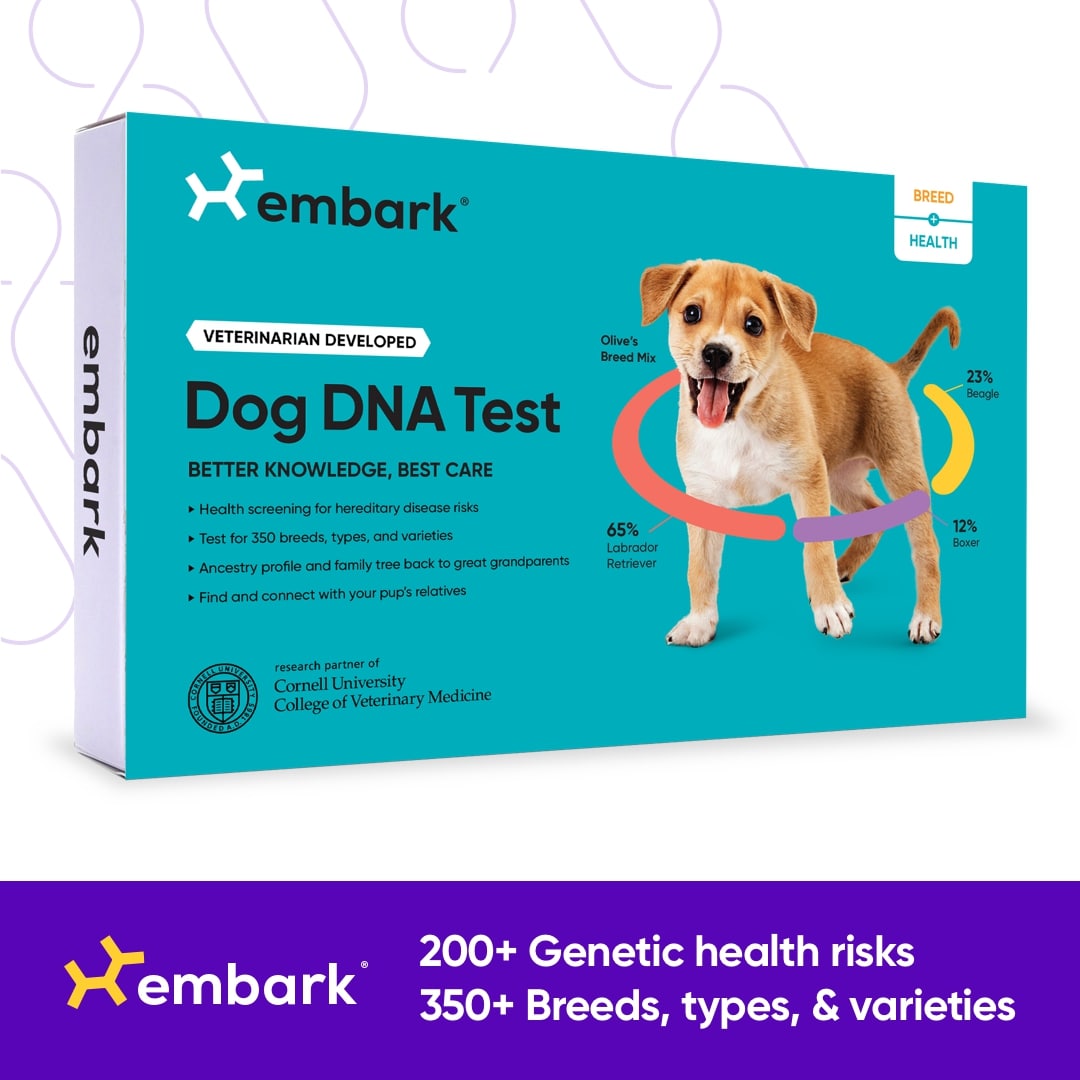
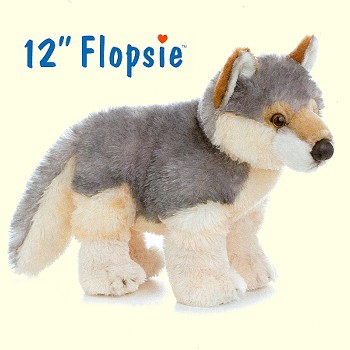 Plush Stuffed Wolf from Stuffed Ark
Plush Stuffed Wolf from Stuffed Ark 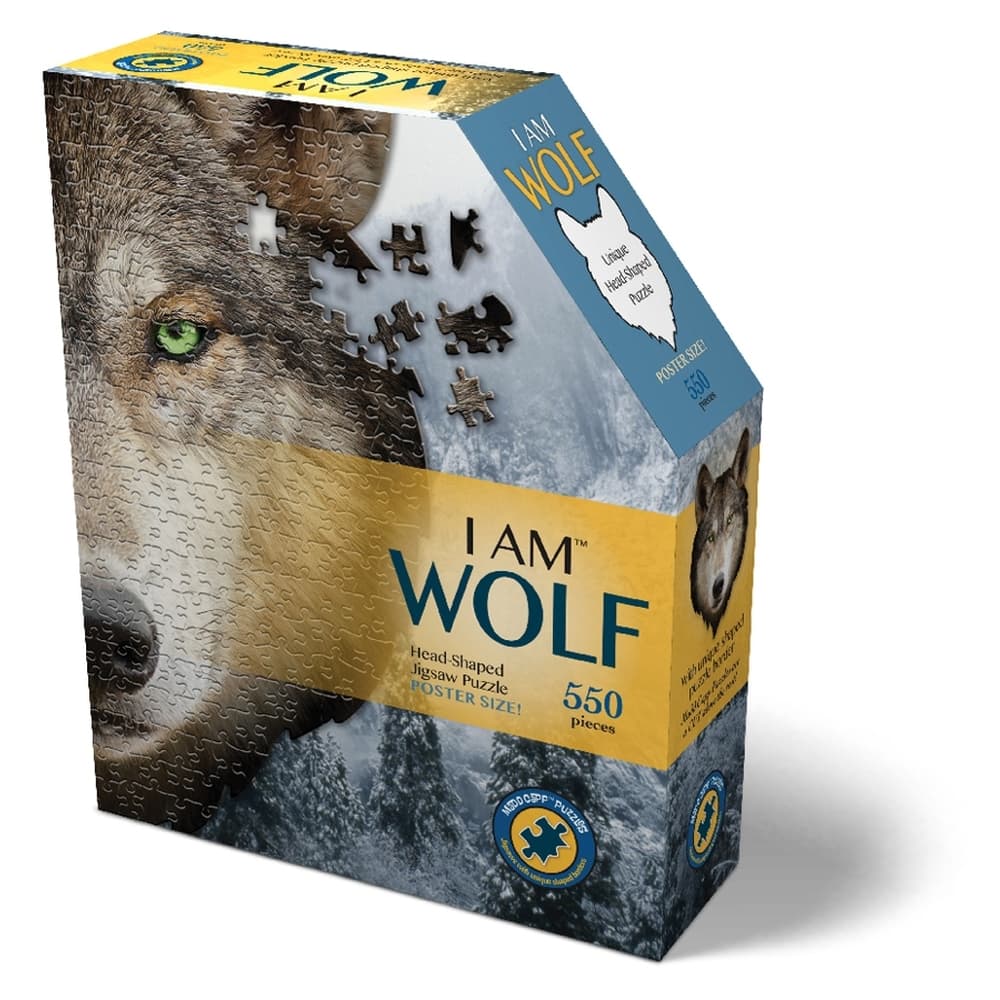 Wolf Puzzle
Wolf Puzzle 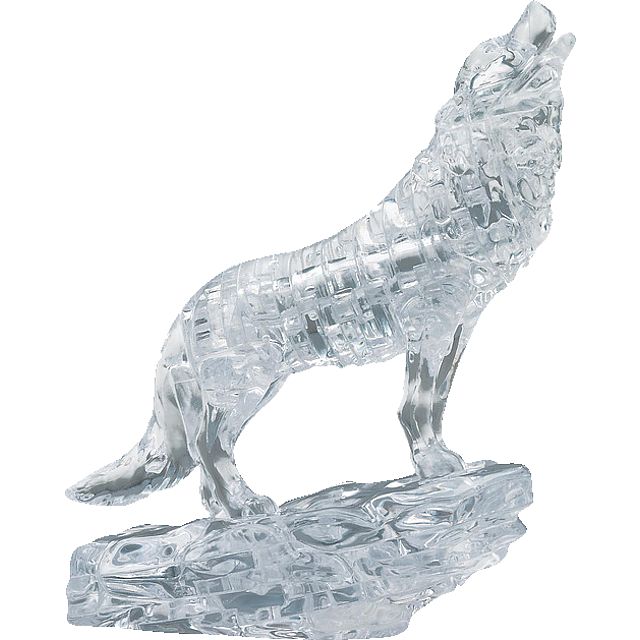 Crystal 3-D Wolf Puzzle
Crystal 3-D Wolf Puzzle .jpg)
